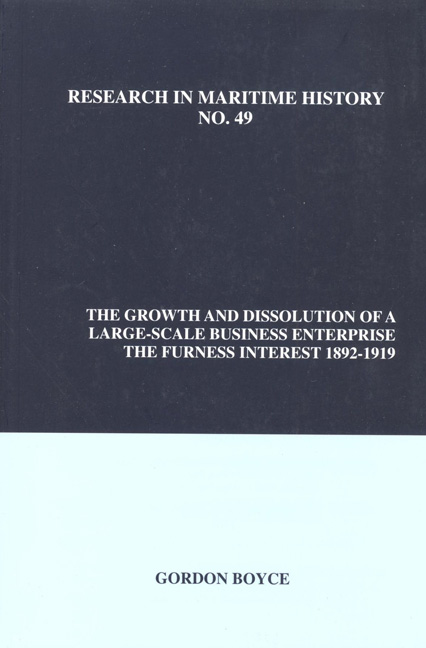Book contents
- Frontmatter
- Table of Contents
- About the Author
- Acknowledgements
- Figures and Tables
- Introduction
- Chapter 1 Furness' Shipping Services: Growth by Organic Means in the 1880s
- Chapter 2 The 1890s: Furness Withy's Expansion by Acquisition and Promotion
- Chapter 3 Diversification into the Industrial Sector, 1895-1901
- Chapter 4 Trouble on the Transatlantic Route: The Formation of the IMM and Furness' Response
- Chapter 5 The Growth of Shipping Services, 1902-1909
- Chapter 6 Industrial Operations and Performance, 1900-1914
- Chapter 7 The Growth of the Shipping Interests, 1910-1919
- Chapter 8 Structure
- Chapter 9 Finance
- Chapter 10 Holding Company Investment Activities and Intermediary Operations
- Chapter 11 Personnel
- Chapter 12 Furness
- Chapter 13 Dissolution
- Appendix 1 Development of the Combined Fleet, 1900-1919
- Appendix 2a Patterns of Ownership: The Furness Group, 1919
- Appendix 2b Reorganization of Branch Offices and Superintending Departments, 1911-1912
- Appendix 3a Fluctuations in Freights, Profits, Tonnage Afloat and Merchant Shipping Output
- Appendix 3b Output of Merchant Tonnage (Excluding Warships), 1892-1913
- Appendix 3c Fluctuations in the Price of a 7500-ton Cargo Steamer, 1898-1913
- Appendix 4 Development of the Furness Group: Principal Promotions, Acquisitions and Divestments, 1880-1919
- Appendix 5 Northern Allies and Maritime Associates
- Appendix 6 Contemporary Accounting Law and Conventions, 1845-1914
- Appendix 7 Lord Furness' Movements, 1899-1912
- Bibliography
Chapter 3 - Diversification into the Industrial Sector, 1895-1901
- Frontmatter
- Table of Contents
- About the Author
- Acknowledgements
- Figures and Tables
- Introduction
- Chapter 1 Furness' Shipping Services: Growth by Organic Means in the 1880s
- Chapter 2 The 1890s: Furness Withy's Expansion by Acquisition and Promotion
- Chapter 3 Diversification into the Industrial Sector, 1895-1901
- Chapter 4 Trouble on the Transatlantic Route: The Formation of the IMM and Furness' Response
- Chapter 5 The Growth of Shipping Services, 1902-1909
- Chapter 6 Industrial Operations and Performance, 1900-1914
- Chapter 7 The Growth of the Shipping Interests, 1910-1919
- Chapter 8 Structure
- Chapter 9 Finance
- Chapter 10 Holding Company Investment Activities and Intermediary Operations
- Chapter 11 Personnel
- Chapter 12 Furness
- Chapter 13 Dissolution
- Appendix 1 Development of the Combined Fleet, 1900-1919
- Appendix 2a Patterns of Ownership: The Furness Group, 1919
- Appendix 2b Reorganization of Branch Offices and Superintending Departments, 1911-1912
- Appendix 3a Fluctuations in Freights, Profits, Tonnage Afloat and Merchant Shipping Output
- Appendix 3b Output of Merchant Tonnage (Excluding Warships), 1892-1913
- Appendix 3c Fluctuations in the Price of a 7500-ton Cargo Steamer, 1898-1913
- Appendix 4 Development of the Furness Group: Principal Promotions, Acquisitions and Divestments, 1880-1919
- Appendix 5 Northern Allies and Maritime Associates
- Appendix 6 Contemporary Accounting Law and Conventions, 1845-1914
- Appendix 7 Lord Furness' Movements, 1899-1912
- Bibliography
Summary
Between 1891 and 1919, the Furness Group acquired or promoted nine shipbuilding yards, four engineering concerns, four iron and steel works, five large collieries and other ancillary undertakings. Apart from Withy's Middleton Shipyard, the purchase of three colliery companies and investments in several new shipbuilding firms during World War I, the Group concentrated its investment in the industrial sector between 1895 and 1901 (see appendix 4 and table 3.4 at the end of this chapter). While Furness and his companies also purchased or promoted four major shipping companies during this seven-year period, his drive into the heavy industries of the North East fundamentally changed the composition of the Group.
Furness’ rapid accumulation of coal, steel, engineering and shipbuilding firms took place during the largest merger wave and the most intensive boom in domestic industrial investment in the entire prewar period. The value of securities issued by British industrial firms increased sharply in 1896 and remained at a high level through 1899. The merger mania peaked in 1898-1900 when 650 firms valued at £42 million combined to create 198 new ventures. In 1896, share prices rose steeply according to Smith and Home's index from 111.5 to 134.9 and remained above 140 until 1902. Along with other sectors, particularly the building trade, heavy industries figured prominently in the resurgence of growth that followed the recession of the mid-1890s. It was in this booming environment that Furness dramatically enlarged his industrial interests.
Historians have repeatedly focussed on the merger movement of 1895-1901, which occurred simultaneously in Britain and America, in search of the roots of the modern economic structure in which the large-scale company, rather than the small family firm, acted as “the primary instrument for managing production and distribution.” Overall, while some prominent firms and organizational changes in a few specific industries arose from the combinations that occurred in Britain at the time, no fundamental structural shift occurred across the industrial sector as a whole. Moreover, of those amalgamations that did take place in Britain, many were defensive; several firms in the same industry combined to protect their market. Prominent examples include Imperial Tobacco, United Alkali, Fine Cotton Spinners and Doublers, the Nobel Dynamite Trust and Associated Portland Cement. Vertical combinations arose, but they occurred primarily in the steel, shipbuilding, engineering and armaments industries.
- Type
- Chapter
- Information
- The Growth and Dissolution of a Large-Scale Business EnterpriseThe Furness Interest, 1892-1919, pp. 55 - 84Publisher: Liverpool University PressPrint publication year: 2012



